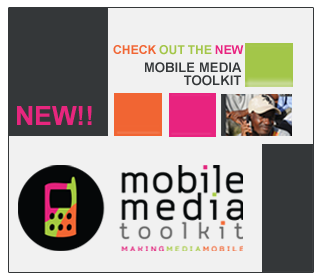The radio station WNYC is creating on-air and online stories from two things very familiar to people in the Northeastern United States: mobile phones and snow. A snowstorm over the holidays was the heaviest December snowfall in six decades and dumped up to 20 inches in many parts of New York City. The story quickly became one of snow removal and how the city was not removing the snow as quickly as people had hoped.
Jim Colgan and the WNYC newsroom wanted to get a sense of what was happening on the streets. Problem was, there was no good or easy way to do this. The station couldn’t rely on the city for real-time information, and reporters couldn’t get to many of the areas. The answer was to have the listeners share their own reports and stories, via mobile phone.
WNYC and programs like The Takeaway (which is broadcast from WNYC and distributed by Public Radio International) are no stranger to mobile technology. "Part of what we are trying to do with the show is be more multi-platform and use interactive tools," Colgan said. The program has used mobile technology in “sourcing through texting” endeavors and frequently receives SMS reports from subscribers ahead of a given show. WNYC and The Takeaway also reach out to audiences on Facebook and the internet, but Colgan said the most direct response comes from connecting with people via mobile phone.
How WNYC reported on the snowstorm of 2010
To report on the first major snowstorm, WNYC asked a very simple question: has your block been plowed? On-air, they asked people to text the word PLOW to the shortcode 30644. Once they did so, that person received a message asking for their address and their response to the question.
After this, the person was sent another message asking if they would like to contribute more details, in their own voice. If the person responded to this SMS message, they were connected to a voicemail line at the station and could tell in their own words how the snowstorm and roads were affecting them. WNYC received hundreds of reports, especially for the first snowstorm, and close to 100 people left voice messages with detailed stories.
Some stories included issues of access to emergency services, getting to and from work, and the ensuing trash buildup after the storm.
A multi-platform approach: Mobile, web, audio, visual
The station took a multi-platform approach to the snow story in that, in addition to mobile and voice responses, it also mapped the reports. Because they had good, clean data from the mobile texts, the team was able to map the information via Google Fusion to create a visual sense of the situation.
The day after the initial snowstorm, when the city had made some headway in clearing snow, WNYC asked for more mobile reports from the public and made a second-day map. On the third day, the station texted everyone that had already participated and asked about their current situation. (Here is a link to all three maps.) At this point, most people texted that local roads were clear, and they were finally able to get out. Visually, this was evident between the three different maps.
A texting service can be a big help
One key to the team’s success was to partner with a texting service, in this case, Mobile Commons. WNYC and The Takeaway have worked with the company in the past, and knew what they could do based on prior experience, Colgan said.
Mobile Commons had in place the platform to help launch the campaign quickly. “It was about 20 minutes between the time we decided to do it and the time we could promote it on the air,” Colgan said. All the station had to do was set up the campaign and the key word. This timeliness is key, especially in breaking news situations.
Mobile Commons' platform also worked very well in that the texted data came in and could be easily exported via CSV to the Google Fusion map, including a public link to the MP3 of a citizen voice report. So, for everyone that called in to leave a message, a site visitor could click on the map and link to hear the detailed audio story associated with that report.
Avoid overuse; Mobile reports are not meant for every story
On the day of this interview with Colgan, fresh snowfall was predicted for the region. I asked if the PLOW campaign would be promoted that day. Colgan warned against overusing a service like this.
WNYC doesn’t want to badger people into sending reports, he said. If it serves the reporting, it is justified. But if it’s evident that streets are being cleared, the reports are obviously not useful.
After the December snowstorm, it became clear that trash was not being picked up, so the station called upon the people who had already texted in about snow removal to see if their trash was being picked up. In this case, the trash reports were not mapped, but WNYC did get voice stories about the situation to play on air.
During a second storm, when New York Mayor Michael Bloomberg was under pressure to show that snow removal was under control, the station did the same thing, and this time, the story became one of how quickly streets had been plowed. “Some people even complained about how many times their streets had been plowed,” Colgan said. In this case, a map was again not needed.
“But it’s really great to know that we have it as a resource the next time this happens,” Colgan said. This mobile, multi-platform approach to news gathering and story telling has potential for uses outside of snowstorms.
| Mapping Snow Via Mobile Phone data sheet 2628 Views | |
|---|---|
| Global Regions: | |
| Countries: | United States |

Post new comment